Abstract
Pyruvate formate-lyase (EC 2.3.1.54), a key enzyme in the anaerobic metabolism of Salmonella typhimurium, catalyzes the conversion of pyruvate to acetyl coenzyme A and formate. pfl::Mu dA operon fusions were isolated for the study of transcriptional regulation. pfl was transcribed both aerobically and anaerobically, but the activity increased about sixfold under anaerobic conditions. The addition of pyruvate, formate, and acetate in nutrient broth did not have any effect on the anaerobic expression of pfl. However, the addition of pyruvate to minimal glucose medium increased the anaerobic expression of pfl. The expression of pfl varied in different growth media. Anaerobic expression of pfl was lower when the culture was grown in minimal glucose medium than when it was grown in nutrient broth. When Casamino Acids (Difco Laboratories, Detroit, Mich.) were added to minimal glucose medium, the expression of pfl increased proportionally with the amount of Casamino Acids added. The transcription of pfl was positively controlled by the oxrA gene product and was affected by both the cya and crp mutations. However, mutations in genes affecting the cyclic AMP-cyclic AMP receptor protein complex or oxrA could not completely abolish the anaerobic derepression of pfl. In merodiploid strains, pfl::Mu dA/F' pfl+, the beta-galactosidase activities were decreased. The mutations gyrA, oxrC, and oxrE, which affected anaerobic metabolism, did not affect anaerobic expression of pfl.
Full text
PDF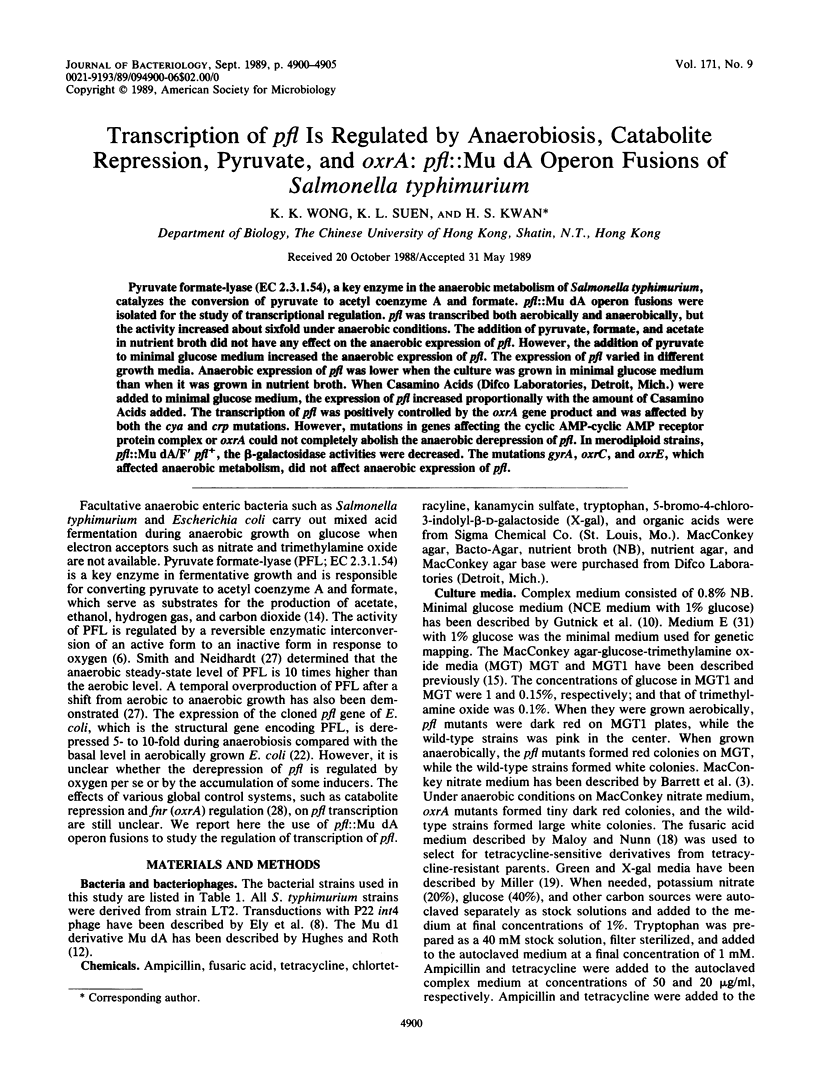
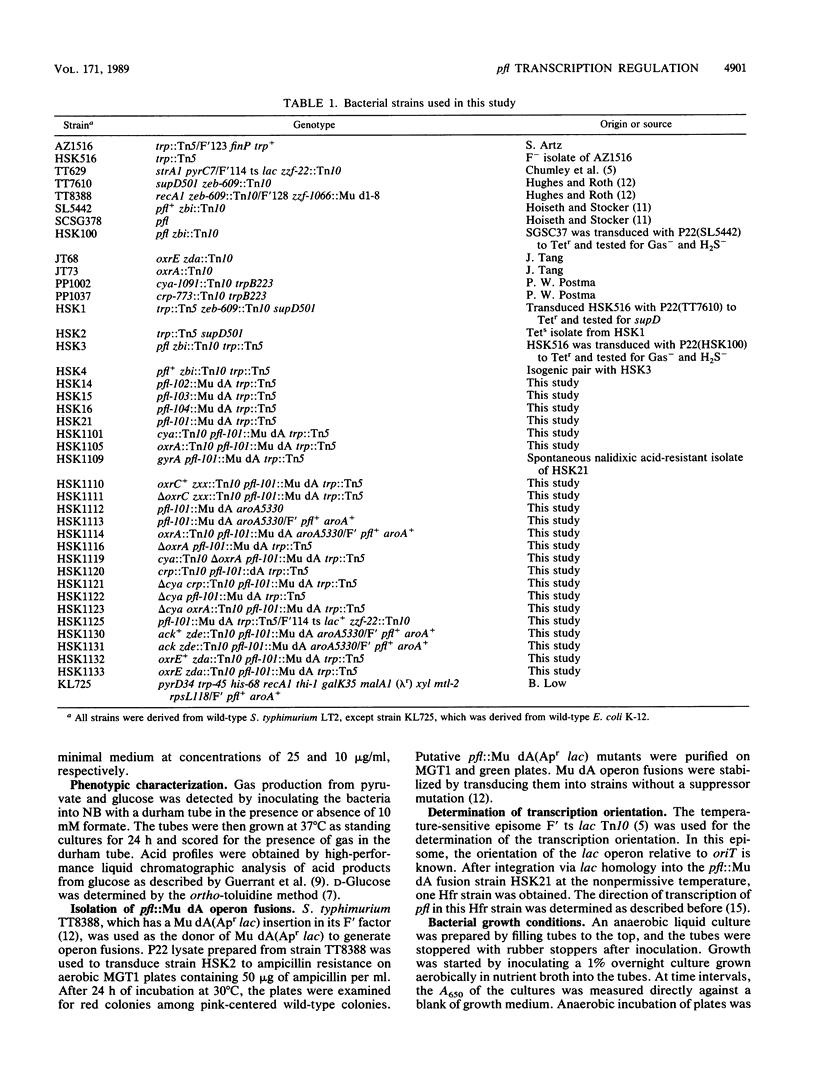
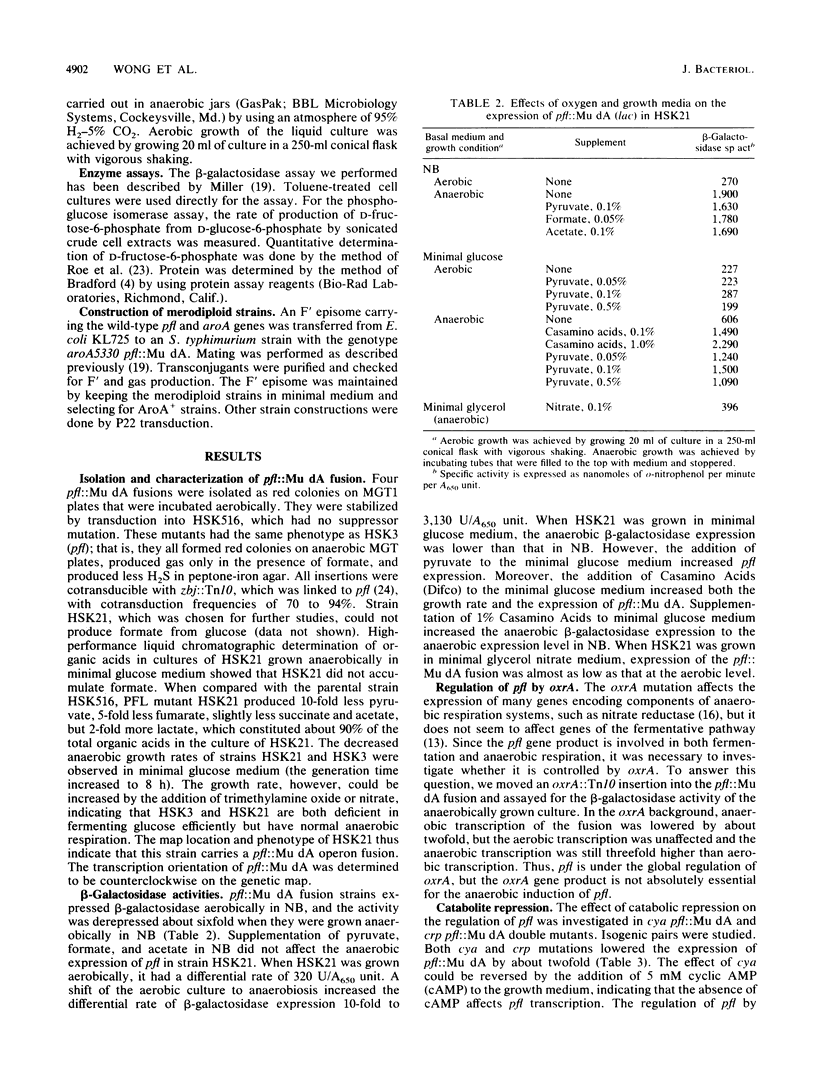
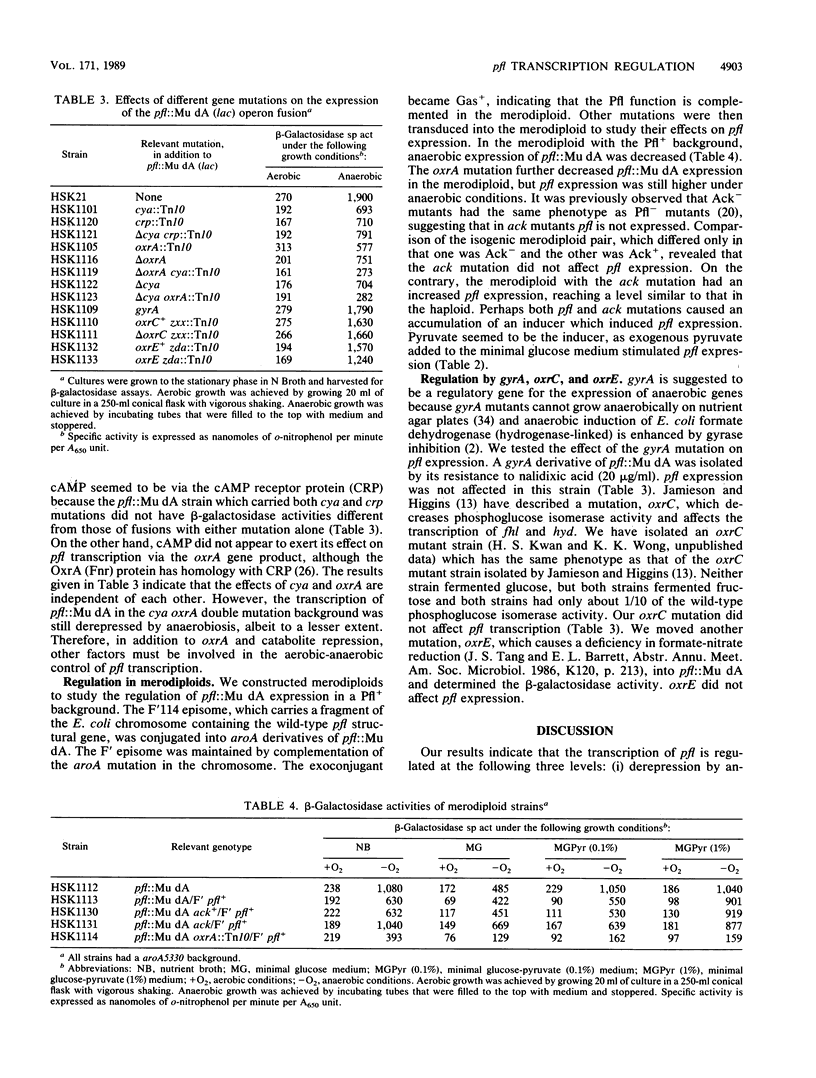
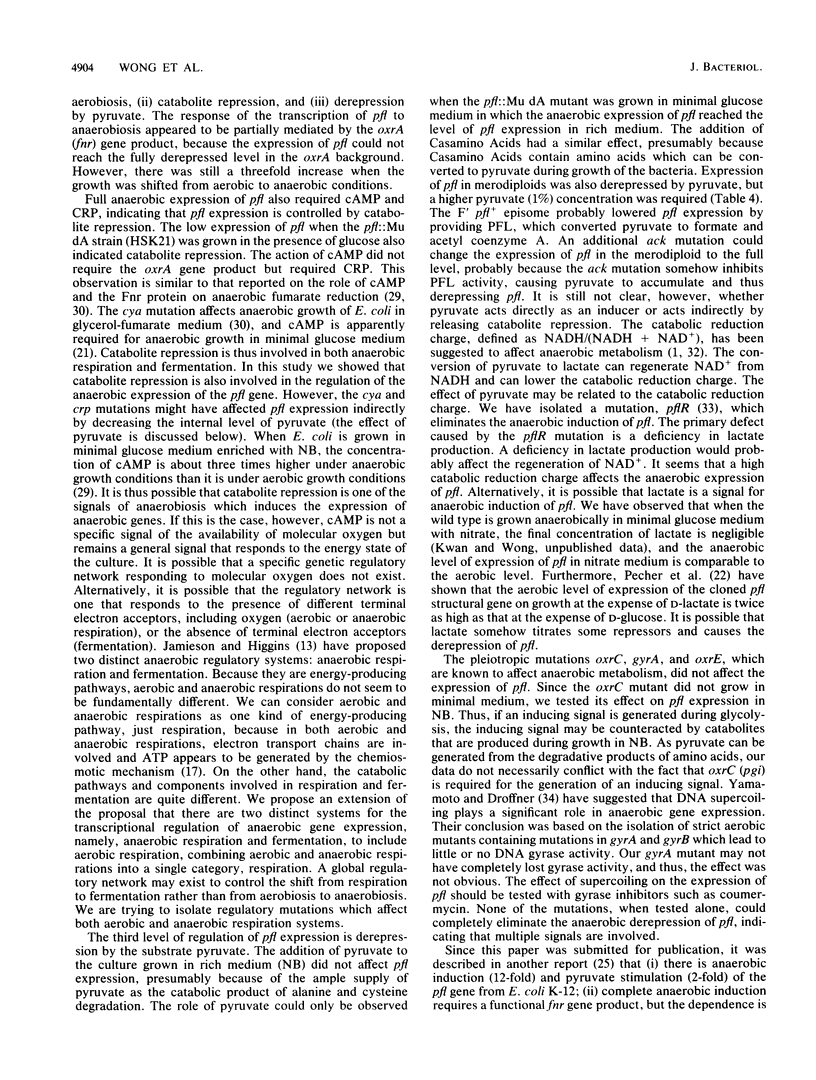
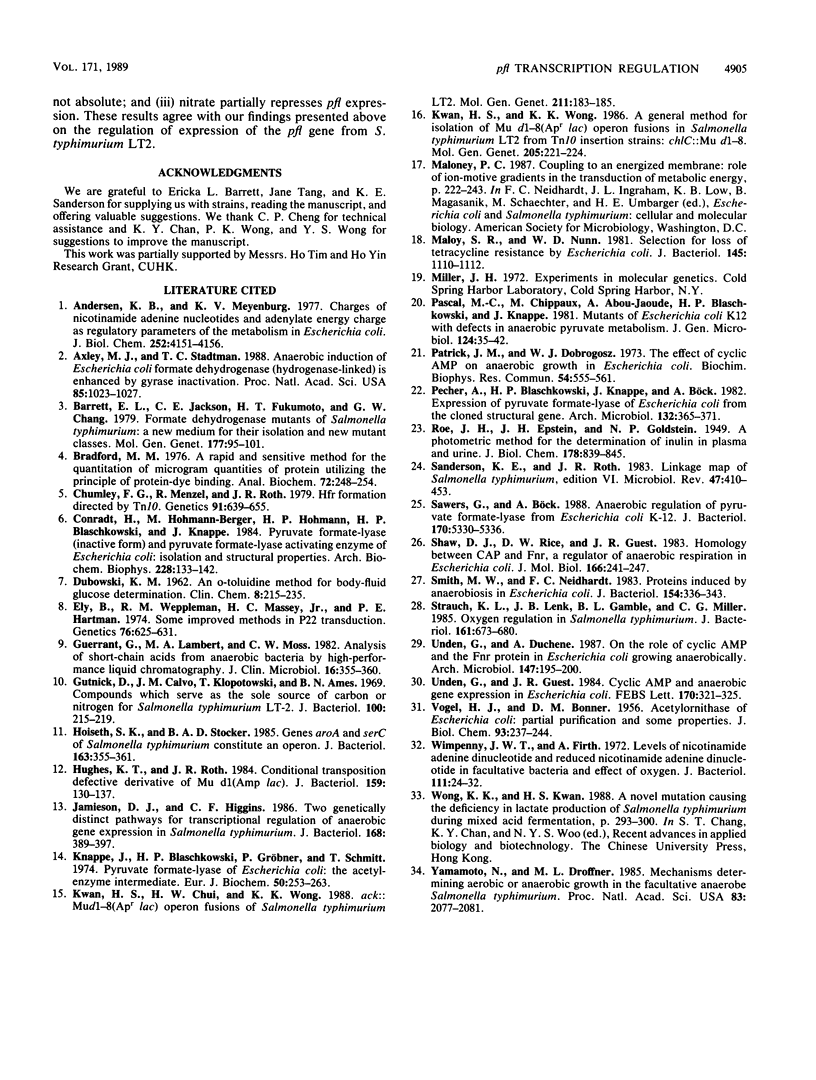
Selected References
These references are in PubMed. This may not be the complete list of references from this article.
- Andersen K. B., von Meyenburg K. Charges of nicotinamide adenine nucleotides and adenylate energy charge as regulatory parameters of the metabolism in Escherichia coli. J Biol Chem. 1977 Jun 25;252(12):4151–4156. [PubMed] [Google Scholar]
- Axley M. J., Stadtman T. C. Anaerobic induction of Escherichia coli formate dehydrogenase (hydrogenase-linked) is enhanced by gyrase inactivation. Proc Natl Acad Sci U S A. 1988 Feb;85(4):1023–1027. doi: 10.1073/pnas.85.4.1023. [DOI] [PMC free article] [PubMed] [Google Scholar]
- Barrett E. L., Jackson C. E., Fukumoto H. T., Chang G. W. Formate dehydrogenase mutants of Salmonella typhimurium: a new medium for their isolation and new mutant classes. Mol Gen Genet. 1979;177(1):95–101. doi: 10.1007/BF00267258. [DOI] [PubMed] [Google Scholar]
- Bradford M. M. A rapid and sensitive method for the quantitation of microgram quantities of protein utilizing the principle of protein-dye binding. Anal Biochem. 1976 May 7;72:248–254. doi: 10.1016/0003-2697(76)90527-3. [DOI] [PubMed] [Google Scholar]
- Chumley F. G., Menzel R., Roth J. R. Hfr formation directed by tn10. Genetics. 1979 Apr;91(4):639–655. doi: 10.1093/genetics/91.4.639. [DOI] [PMC free article] [PubMed] [Google Scholar]
- Conradt H., Hohmann-Berger M., Hohmann H. P., Blaschkowski H. P., Knappe J. Pyruvate formate-lyase (inactive form) and pyruvate formate-lyase activating enzyme of Escherichia coli: isolation and structural properties. Arch Biochem Biophys. 1984 Jan;228(1):133–142. doi: 10.1016/0003-9861(84)90054-7. [DOI] [PubMed] [Google Scholar]
- DUBOWSKI K. M. An o-toluidine method for body-fluid glucose determination. Clin Chem. 1962 May-Jun;8:215–235. [PubMed] [Google Scholar]
- Guerrant G. O., Lambert M. A., Moss C. W. Analysis of short-chain acids from anaerobic bacteria by high-performance liquid chromatography. J Clin Microbiol. 1982 Aug;16(2):355–360. doi: 10.1128/jcm.16.2.355-360.1982. [DOI] [PMC free article] [PubMed] [Google Scholar]
- Gutnick D., Calvo J. M., Klopotowski T., Ames B. N. Compounds which serve as the sole source of carbon or nitrogen for Salmonella typhimurium LT-2. J Bacteriol. 1969 Oct;100(1):215–219. doi: 10.1128/jb.100.1.215-219.1969. [DOI] [PMC free article] [PubMed] [Google Scholar]
- Hartman P. E. Some improved methods in P22 transduction. Genetics. 1974 Apr;76(4):625–631. doi: 10.1093/genetics/76.4.625. [DOI] [PMC free article] [PubMed] [Google Scholar]
- Hoiseth S. K., Stocker B. A. Genes aroA and serC of Salmonella typhimurium constitute an operon. J Bacteriol. 1985 Jul;163(1):355–361. doi: 10.1128/jb.163.1.355-361.1985. [DOI] [PMC free article] [PubMed] [Google Scholar]
- Hughes K. T., Roth J. R. Conditionally transposition-defective derivative of Mu d1(Amp Lac). J Bacteriol. 1984 Jul;159(1):130–137. doi: 10.1128/jb.159.1.130-137.1984. [DOI] [PMC free article] [PubMed] [Google Scholar]
- Jamieson D. J., Higgins C. F. Two genetically distinct pathways for transcriptional regulation of anaerobic gene expression in Salmonella typhimurium. J Bacteriol. 1986 Oct;168(1):389–397. doi: 10.1128/jb.168.1.389-397.1986. [DOI] [PMC free article] [PubMed] [Google Scholar]
- Knappe J., Blaschkowski H. P., Gröbner P., Schmitt T. Pyruvate formate-lyase of Escherichia coli: the acetyl-enzyme intermediate. Eur J Biochem. 1974 Dec 16;50(1):253–263. doi: 10.1111/j.1432-1033.1974.tb03894.x. [DOI] [PubMed] [Google Scholar]
- Kwan H. S., Chui H. W., Wong K. K. ack::Mu d1-8 (Apr lac) operon fusions of Salmonella typhimurium LT2. Mol Gen Genet. 1988 Jan;211(1):183–185. doi: 10.1007/BF00338411. [DOI] [PubMed] [Google Scholar]
- Kwan H. S., Wong K. K. A general method for isolation of Mu d1-8(Aprlac) operon fusions in Salmonella typhimurium LT2 from Tn10 insertion strains: chlC::Mu d1-8. Mol Gen Genet. 1986 Nov;205(2):221–224. doi: 10.1007/BF00430431. [DOI] [PubMed] [Google Scholar]
- Maloy S. R., Nunn W. D. Selection for loss of tetracycline resistance by Escherichia coli. J Bacteriol. 1981 Feb;145(2):1110–1111. doi: 10.1128/jb.145.2.1110-1111.1981. [DOI] [PMC free article] [PubMed] [Google Scholar]
- Pascal M. C., Chippaux M., Abou-Jaoudé A., Blaschkowski H. P., Knappe J. Mutants of Escherichia coli K12 with defects in anaerobic pyruvate metabolism. J Gen Microbiol. 1981 May;124(1):35–42. doi: 10.1099/00221287-124-1-35. [DOI] [PubMed] [Google Scholar]
- Patrick J. M., Dobrogosz W. J. The effect of cyclic AMP on anaerobic growth of Escherichia coli. Biochem Biophys Res Commun. 1973 Sep 18;54(2):555–561. doi: 10.1016/0006-291x(73)91458-7. [DOI] [PubMed] [Google Scholar]
- Pecher A., Blaschkowski H. P., Knappe K., Böck A. Expression of pyruvate formate-lyase of Escherichia coli from the cloned structural gene. Arch Microbiol. 1982 Oct;132(4):365–371. doi: 10.1007/BF00413390. [DOI] [PubMed] [Google Scholar]
- Sanderson K. E., Roth J. R. Linkage map of Salmonella typhimurium, Edition VI. Microbiol Rev. 1983 Sep;47(3):410–453. doi: 10.1128/mr.47.3.410-453.1983. [DOI] [PMC free article] [PubMed] [Google Scholar]
- Sawers G., Böck A. Anaerobic regulation of pyruvate formate-lyase from Escherichia coli K-12. J Bacteriol. 1988 Nov;170(11):5330–5336. doi: 10.1128/jb.170.11.5330-5336.1988. [DOI] [PMC free article] [PubMed] [Google Scholar]
- Shaw D. J., Rice D. W., Guest J. R. Homology between CAP and Fnr, a regulator of anaerobic respiration in Escherichia coli. J Mol Biol. 1983 May 15;166(2):241–247. doi: 10.1016/s0022-2836(83)80011-4. [DOI] [PubMed] [Google Scholar]
- Smith M. W., Neidhardt F. C. Proteins induced by anaerobiosis in Escherichia coli. J Bacteriol. 1983 Apr;154(1):336–343. doi: 10.1128/jb.154.1.336-343.1983. [DOI] [PMC free article] [PubMed] [Google Scholar]
- Strauch K. L., Lenk J. B., Gamble B. L., Miller C. G. Oxygen regulation in Salmonella typhimurium. J Bacteriol. 1985 Feb;161(2):673–680. doi: 10.1128/jb.161.2.673-680.1985. [DOI] [PMC free article] [PubMed] [Google Scholar]
- Unden G., Duchene A. On the role of cyclic AMP and the Fnr protein in Escherichia coli growing anaerobically. Arch Microbiol. 1987 Mar;147(2):195–200. doi: 10.1007/BF00415284. [DOI] [PubMed] [Google Scholar]
- Unden G., Guest J. R. Cyclic AMP and anaerobic gene expression in E. coli. FEBS Lett. 1984 May 21;170(2):321–325. doi: 10.1016/0014-5793(84)81336-8. [DOI] [PubMed] [Google Scholar]
- Wimpenny J. W., Firth A. Levels of nicotinamide adenine dinucleotide and reduced nicotinamide adenine dinucleotide in facultative bacteria and the effect of oxygen. J Bacteriol. 1972 Jul;111(1):24–32. doi: 10.1128/jb.111.1.24-32.1972. [DOI] [PMC free article] [PubMed] [Google Scholar]
- Yamamoto N., Droffner M. L. Mechanisms determining aerobic or anaerobic growth in the facultative anaerobe Salmonella typhimurium. Proc Natl Acad Sci U S A. 1985 Apr;82(7):2077–2081. doi: 10.1073/pnas.82.7.2077. [DOI] [PMC free article] [PubMed] [Google Scholar]


